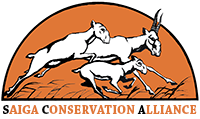Today we’d like to tell you about Natalia Shivaldova –
Interviewer: When were you first interested in saiga?
N.Sh.: In 2012 I took an interest in saiga protection and conservation. I had never realised before that saiga were in such dire straits and we risked losing them forever.
Interviewer: When did you begin studying saiga and working on their conservation?
N.Sh.: My colleagues, specialists in environmental protection at the Institute of Zoology, Academy of Sciences of the Republic of Uzbekistan and the Saiga Conservation Alliance, suggested that I join a team of authors to co-write an interactive coursebook for school students and a methodological guidebook for teachers. At about that time we had the idea to establish school-based children’s steppe clubs. It was important to acquaint children with the saiga and kindle love for this animal in them, as well as to arouse teachers’ interest in this rare species and its
Interviewer: Could you describe your typical day?
N.Sh.: I’m engaged in all sorts of activities, from administrative to journalistic. I travel a lot and meet many people. Among typical things I do is
Interviewer: Could you tell us an interesting story about saigas?
N.Sh.: Saigas inhabit regions with a sharply continental climate. The climate has grown even harsher after the loss of the Aral Sea. The area features strong temperature fluctuations and fierce winds. The weather is unpredictable. Old people in remote villages on the Ustyurt Plateau tell me that once in a very cold winter a sharp frost came after heavy snowfall to cover the snow layer with a thick and unbreakable ice crust. On the coldest
Interviewer: What are the main challenges in your work?
N.Sh.: The challenges that heavily impede the entire business are the low awareness throughout society, from local people through to decision makers. Unfortunately, a leftover principle predominates in many people’s attitudes to environmental protection; commerce and immediate profit are their absolute priorities. We need more information and reliable printed materials. We need more human resources for the efficient control of poaching. Like animals, people migrate in search of better places to live and higher earnings. This also complicates activities within the saiga’s habitats because people who we work with leave the area.
Interviewer: What are the ways to overcome those obstacles in your work?
N.Sh.: It is essential to raise awareness at all levels. We need to involve security agencies, such as the Customs Committee, Ministry of Internal Affairs and local authorities to increase the range of partners and like-minded people. It is important to involve local commercial
Interviewer: Which is the best aspect of your work?
N.Sh.: It is to watch its fruit; to see the burning eyes of children when they are drawing saigas and hear how much love and tenderness they show when talking about the animals. To see ordinary people’s growing interest, activity
Interviewer: What are the prospects for your saiga conservation activities? What are the first steps that need to be taken to help this species to survive?
N.Sh.: It is important to intensify lawmaking activities, consolidate the administrative code and increase answerability for the infliction of damage to this relict antelope and the entire steppe ecosystem. It is also important to detect announcements about the buying of saiga horns and to struggle with illegal horn trafficking.
Interviewer: You have been working on the study and conservation of rare species for over a decade. What changes have taken place over these years? What are the current tendencies in this field?
N.Sh.: It is already impossible to ignore the problem. There is a growing number of concerned people who dream of making a contribution to the conservation of rare species. Social networks are a good means to consolidate efforts. Nevertheless, there are not enough human and technical resources available. We have not yet succeeded in changing the minds of hunters in villages near saiga habitats, which is complicated by numerous social problems in local communities. Children are our hope and support; they are very sensitive and flexible. They even succeed in changing the minds of their parents. For instance, they can uncompromisingly refuse to eat saiga meat. Nevertheless, up until recently we often found ourselves in situations where many schoolchildren couldn’t identify saigas in pictures we show them. They made various suggestions, such as that it was an anteater, elephant, deer or something else. Today they are more closely acquainted with saigas and understand the species better. Now we don’t think any of today’s schoolboys will become poachers in the future. It is much more difficult to change adults’ opinion about, and attitude towards, saigas.




